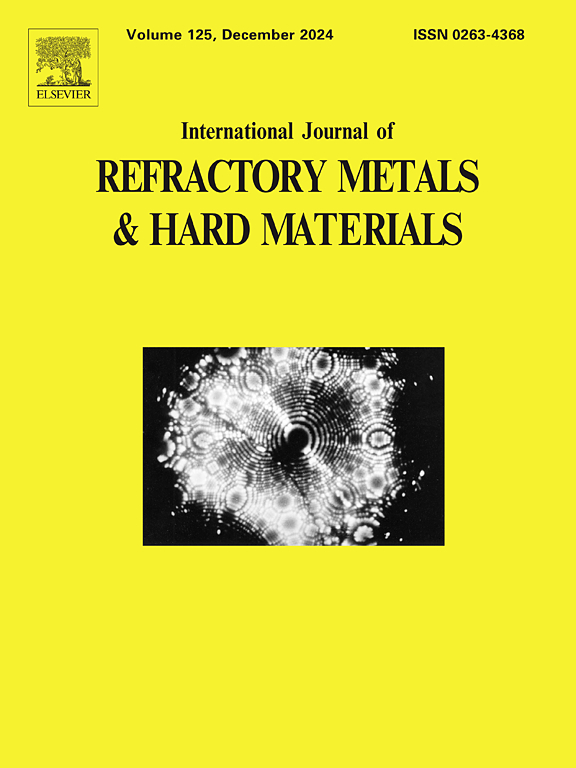钛基金属玻璃基复合材料中成分驱动的孪生激活和动态应变硬化
IF 4.2
2区 材料科学
Q2 MATERIALS SCIENCE, MULTIDISCIPLINARY
International Journal of Refractory Metals & Hard Materials
Pub Date : 2025-05-13
DOI:10.1016/j.ijrmhm.2025.107230
引用次数: 0
摘要
一种原位钛基金属玻璃基复合材料Ti43Zr32Ni7Ta4Be14 (at。%),通过Ti43Zr32Ni6Ta5Be14 (at。%),通过孪生激活实现更卓越的动态机械性能。该复合材料在动态加载(1000 ~ 1500/s)下的屈服强度(1712 ~ 1811 MPa)和塑性(3.3%)均优于优化前的复合材料,该复合材料利用了协同的孪晶诱导塑性和位错机制来抵消基体软化机制。组分调谐通过电负性/原子半径优化(例如,Ni取代Ta)降低了层错能,促进了玻璃晶体界面的变形孪晶和应力重新分布。有限元分析和改进的Johnson-Cook模型验证了应变率强化、绝热加热和界面载荷传递之间的协同作用,而多尺度微观结构表征证实了剪切带演化、位错机制和孪晶是关键的塑性增强剂。本文章由计算机程序翻译,如有差异,请以英文原文为准。
Composition-driven twinning activation and dynamic strain hardening in Ti-based metallic glass matrix composite
An in-situ Ti-based metallic glass matrix composite Ti43Zr32Ni7Ta4Be14 (at. %), optimized via compositional refinement from Ti43Zr32Ni6Ta5Be14 (at. %), achieves more exceptional dynamic mechanical performance through twinning activation. This composite demonstrates enhanced yield strength (1712–1811 MPa) and plasticity (3.3 %) under dynamic loading (1000–1500/s), outperforming the one before optimizing, by utilizing synergistic twinning-induced plasticity and dislocation mechanisms to counteract matrix softening mechanism. Compositional tuning reduces stacking fault energy via electronegativity/atomic radius optimization (e.g., Ni substitution for Ta), facilitating deformation twinning and stress redistribution at glass-crystal interfaces. Finite element analysis and a modified Johnson-Cook model validate the synergy between strain-rate strengthening, adiabatic heating, and interfacial load transfer, while multiscale microstructural characterization confirms shear bands evolution, dislocation mechanism and twins as critical plasticity enhancers.
求助全文
通过发布文献求助,成功后即可免费获取论文全文。
去求助
来源期刊
CiteScore
7.00
自引率
13.90%
发文量
236
审稿时长
35 days
期刊介绍:
The International Journal of Refractory Metals and Hard Materials (IJRMHM) publishes original research articles concerned with all aspects of refractory metals and hard materials. Refractory metals are defined as metals with melting points higher than 1800 °C. These are tungsten, molybdenum, chromium, tantalum, niobium, hafnium, and rhenium, as well as many compounds and alloys based thereupon. Hard materials that are included in the scope of this journal are defined as materials with hardness values higher than 1000 kg/mm2, primarily intended for applications as manufacturing tools or wear resistant components in mechanical systems. Thus they encompass carbides, nitrides and borides of metals, and related compounds. A special focus of this journal is put on the family of hardmetals, which is also known as cemented tungsten carbide, and cermets which are based on titanium carbide and carbonitrides with or without a metal binder. Ceramics and superhard materials including diamond and cubic boron nitride may also be accepted provided the subject material is presented as hard materials as defined above.

 求助内容:
求助内容: 应助结果提醒方式:
应助结果提醒方式:


